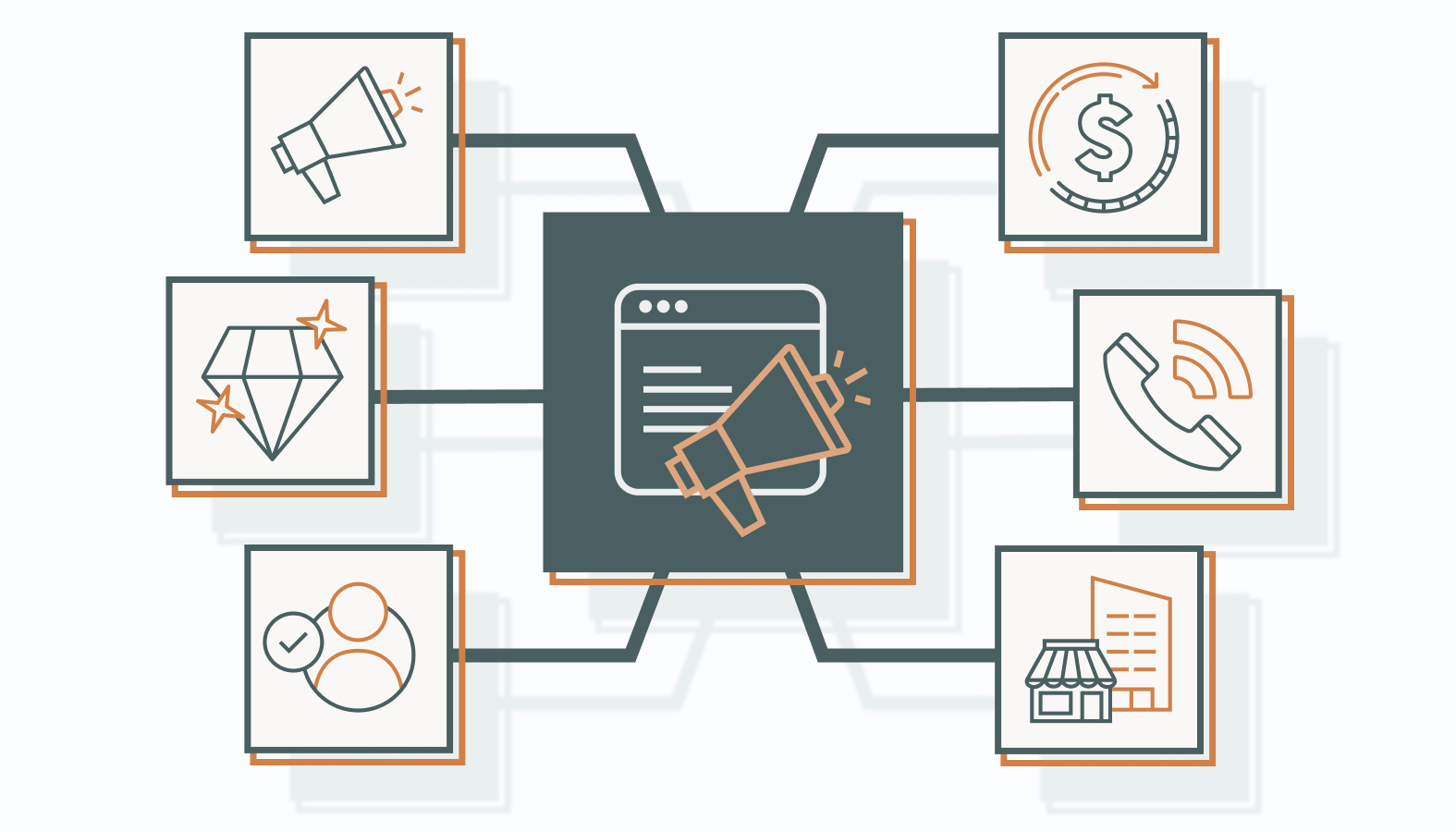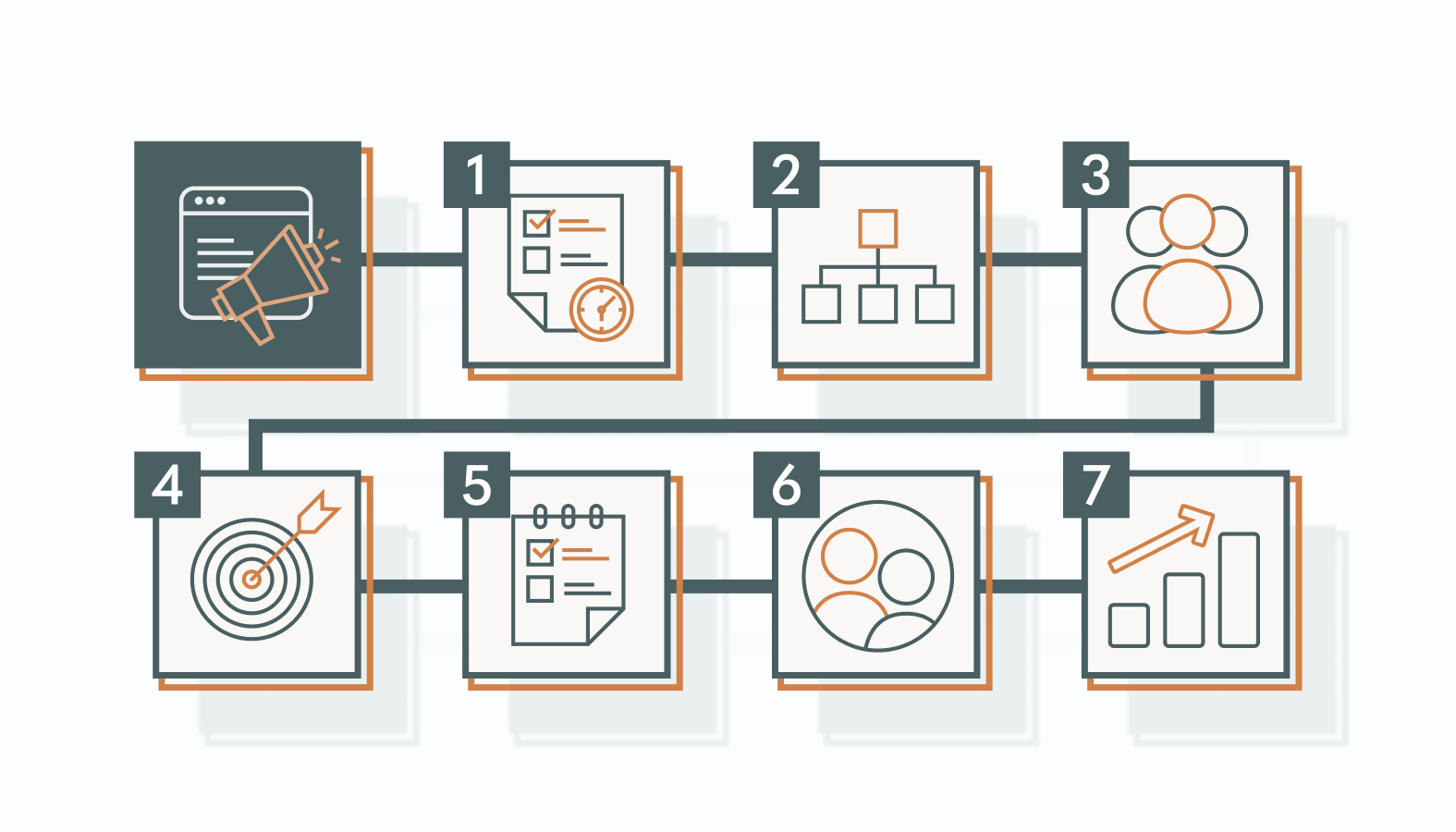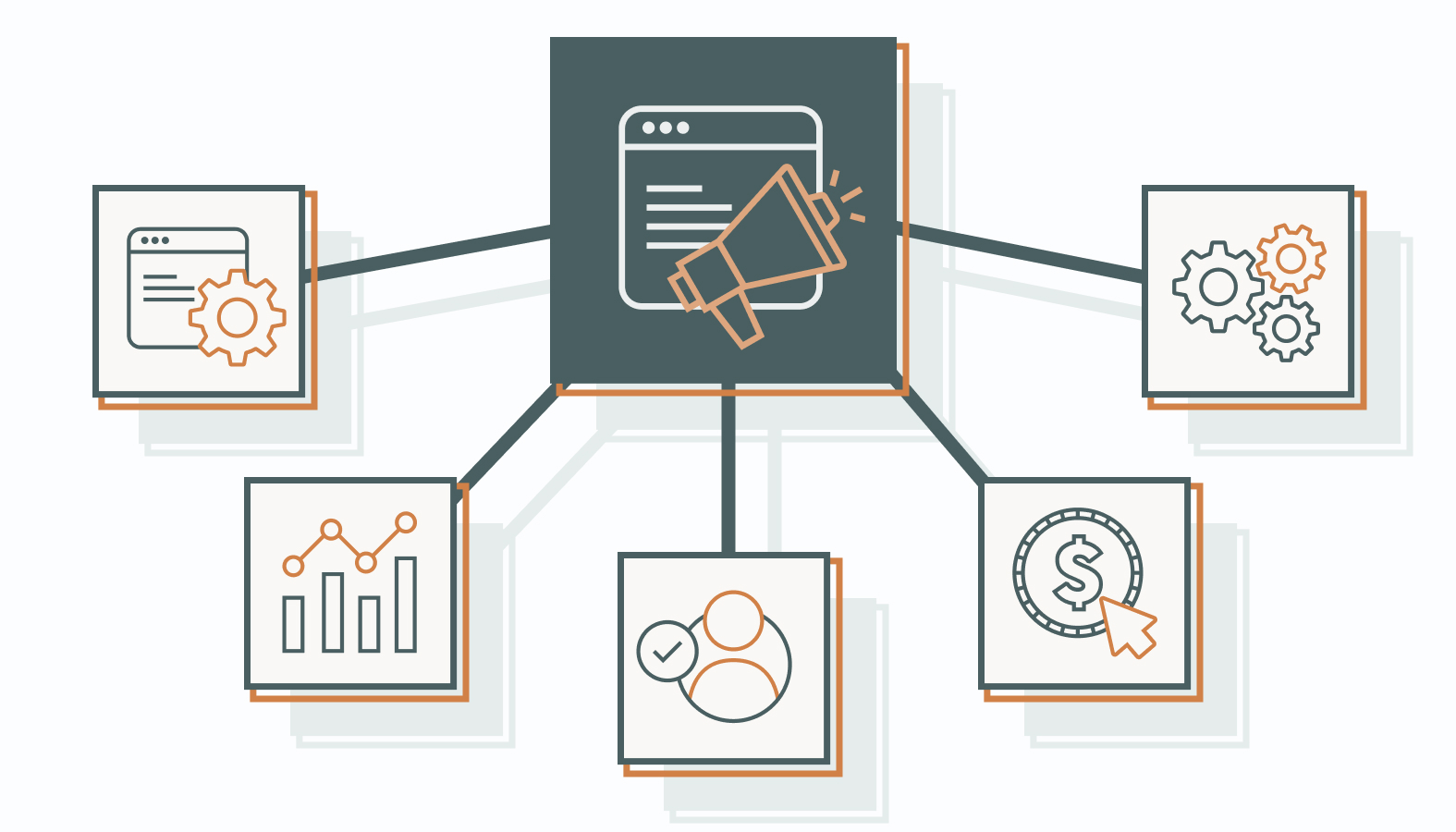Tired of throwing darts in the dark and hoping they land on a bullseye? Traditional B2B marketing often feels like a shot in the dark, with countless leads and little to show for it.
Account-based marketing (ABM) is a strategic approach that flips the script. Instead of casting a wide net, ABM focuses on a select group of high-value accounts. When businesses focus marketing and sales efforts on these specific accounts, they build stronger relationships, increase engagement, and ultimately drive revenue.
However, ABM isn’t a silver bullet. It requires a deep understanding of target accounts, a coordinated effort between marketing and sales, and the ability to measure and optimize results.
In this post, we’ll discuss the ins and outs of ABM and how you can leverage it to achieve your business goals.
The Importance of Aligning Marketing and Sales
A united front between marketing and sales is no longer a nice-to-have; it’s a must-have. When these teams work together seamlessly with an ABM strategy, they can:
Enhance Targeting Efficiency
Marketing and sales teams can collaborate closely to identify accounts with the greatest potential and run efficient account-based campaigns.
Unify Messaging
Consistency is key in ABM.
Aligned marketing and sales teams are more likely to deliver a consistent message across all channels.
Imagine receiving a personalized email from a salesperson, a relevant blog post, and a targeted social media ad.
This consistent experience builds trust and credibility with target accounts, making converting leads into loyal customers easier.
Streamline Processes
When marketing and sales teams are on the same page, they create a seamless customer journey from initial outreach to the final handshake.
Every step is coordinated and intentional, ensuring leads are nurtured effectively and converted into customers quickly.
Utilize Shared Metrics and Goals
When marketing and sales teams share the same goals and metrics, everyone’s working towards the same objectives.
This shared vision fosters collaboration and accountability. It’s like a well-oiled machine, with each team member playing a crucial role in driving growth and closing deals.
Advantages of Implementing Account-Based Marketing
Account-Based Marketing (ABM) is a powerful strategy that’s reshaping the B2B marketing landscape. It lets businesses deliver highly personalized marketing campaigns that increase engagement and drive better results.
Let’s explore other benefits of implementing ABM.
Marketing and Sales Alignment
ABM bridges the gap between marketing and sales, empowering teams to collaborate on high-value accounts and score bigger wins.
Relevance Maximization
Imagine treating each of your target accounts like a VIP. With ABM, you can do just that.
By understanding their specific needs and challenges, you can create highly personalized marketing campaigns that resonate deeply.
It’s like sending a hand-written note to a friend, tailored just for them. This level of personalization captures attention and drives real results.
Consistent Customer Experiences
ABM delivers a consistent and personalized customer experience. Every touchpoint is customized from the first time a potential client interacts with your brand to long after the sale.
This seamless journey builds trust, loyalty, and long-term customer relationships.
Leveraging ABM, you can deliver every marketing email, sales call, and customer support interaction that feels tailor-made for the individual.
ROI Measurement
ABM isn’t just about strategy; it’s about results. With ABM, you can track the impact of your marketing efforts on a granular level.
Measuring revenue generated, customer lifetime value, ROI, and other metrics allow you to see exactly what’s working and what’s not.
This data-driven approach helps you optimize your campaigns and make informed decisions that drive business growth.
Streamlining Sales Cycles
ABM is a high-speed engine for closing deals.
Focusing on crucial decision-makers and delivering personalized messages help expedite the sales process – going from initial contact to a closed deal in record time.
Business Expansion Through Account Relationships
ABM isn’t just about acquiring new customers; it’s about nurturing existing ones.
Businesses can unlock a world of opportunities by building strong, trust-based relationships.
Imagine a customer who’s so satisfied with your product that they become your biggest advocate.
From upselling and cross-selling to expanding into new markets, these deep connections can drive significant business growth.
Creating and Implementing an Account-Based Marketing Strategy
In today’s competitive B2B landscape, a one-size-fits-all marketing approach is ineffective.
Account-Based Marketing (ABM) is a modern solution that targets specific, high-value accounts with laser precision. Focusing on a select group of ideal customers, ABM helps businesses maximize their marketing efforts and drive significant growth.
Let’s continue with the steps to building a winning ABM strategy.
Establishing Your ABM Framework
A solid ABM strategy begins with establishing a well-defined ABM framework. This structured foundation acts as a roadmap, guiding your efforts and ensuring that all actions align with your strategic objectives.
Without this framework, efforts can become disjointed, reducing the potential impact of ABM.
Collaborating with Marketing and Sales Teams
Successful ABM strategies are built by a strong alliance between marketing and sales teams. To foster this collaboration, consider implementing the following strategies:
- Joint Planning Sessions: Regular meetings where both teams discuss upcoming campaigns, share insights, and align on goals.
- Shared Tools and Technology: Leveraging CRM and marketing automation tools to streamline processes and improve data visibility.
- Co-created Content: Collaborating on content pieces like case studies, webinars, and email campaigns that resonate with target accounts.
The results of an effective ABM partnership are undeniable. Imagine a scenario where sales reps are armed with personalized marketing materials that directly address their prospects’ pain points. Or, consider a marketing campaign that generates high-quality leads perfectly aligned with sales target accounts.
Qualifying and Prioritizing Accounts
Not all accounts are created equal. To maximize the impact of your ABM efforts, you need to identify and prioritize high-value accounts that perfectly fit your offerings.
Key criteria for qualifying and prioritizing accounts include:
- Ideal Customer Profile (ICP): Clearly define the characteristics of your ideal customer, including industry, company size, job titles, and pain points.
- Revenue Potential: Assess each account’s potential revenue, considering factors like deal size and contract length.
- Strategic Fit: Evaluate how well each account aligns with your long-term business goals and product roadmap.
- Engagement Level: Consider existing relationships and recent interactions to gauge the level of interest and receptiveness.
By carefully selecting and prioritizing your target accounts, you can focus your resources on the opportunities that will deliver the greatest impact.
Crafting Your Market Approach
Crafting a personalized go-to-market strategy captures the attention of your target accounts.
By understanding each account’s unique needs and challenges, you can tailor your value proposition to resonate deeply. This customized approach increases engagement and significantly improves conversion rates.
Developing Your ABM Strategy
The next step is to develop a comprehensive ABM strategy that transforms your framework into actionable plans.
1) Utilizing Planning Templates
Planning templates are invaluable tools in ABM strategy development. By using these templates, you can ensure consistency, clarity, and efficiency in every campaign.
Here’s how planning templates can help:
- Clear Objectives: Define specific, measurable, achievable, relevant, and time-bound (SMART) goals for each campaign.
- Role Clarity: Assign clear roles and responsibilities to team members, ensuring everyone knows their part in the process.
- Consistent Messaging: Develop a unified brand voice and messaging that resonates with your target accounts.
- Efficient Execution: Utilize templates to accelerate the campaign planning and execution process.
Leveraging planning templates can save time, reduce errors, and improve the overall effectiveness of your ABM initiatives.
2) Achieving Company-Wide Alignment
To truly unlock the power of ABM, you need buy-in from every corner of your organization. Secure leadership support and align ABM initiatives with broader company goals to create a unified front.
Here’s how to achieve company-wide alignment:
- Executive Sponsorship: Enlist the support of C-suite executives to champion ABM and allocate necessary resources.
- Cross-Functional Collaboration: Foster collaboration between marketing, sales, customer success, and other relevant teams to ensure a cohesive approach.
- Clear Communication: Communicate the benefits of ABM to all employees, highlighting how it can contribute to individual and team success.
- Performance Metrics: Establish clear KPIs and regularly track progress to demonstrate the value of ABM.
When your organization is aligned with ABM, you can create a powerful force that drives growth and customer satisfaction.
3) Assembling Your ABM Team
A successful ABM program requires a talented and dedicated team.
Key roles in an ABM team include:
- Account Executives: Frontline sales professionals who build relationships with key decision-makers.
- Marketing Strategists: Experts in developing and executing targeted marketing campaigns.
- Content Marketers: Skilled content creators who develop compelling content tailored to specific accounts.
- Data Analysts: Data wizards who analyze customer data to inform strategy and measure performance.
Assembling a team with the right mix of skills and expertise can be a game-changer for your business.
4) Identifying and Selecting Target Accounts
The key to a successful ABM strategy lies in identifying and targeting the right accounts. Use tried-and-tested research methods and tools to uncover hidden gems and focus your efforts on the most promising opportunities.
Key techniques for identifying target accounts include:
- Market Research: Gain a deep understanding of your industry, market trends, and customer needs.
- Predictive Analytics: Use data-driven insights to identify accounts with high potential.
- Competitive Analysis: Analyze your competitors’ target accounts to identify gaps and opportunities.
- Account Profiling: Create detailed profiles of your ideal customers, including their demographics, firmographics, and buying behaviors.
5) Completing and Implementing Account Plans
With your target accounts identified, it’s time to develop customized game plans to win them over.
Include these into your plan:
- Clear Objectives: Define specific goals, such as increasing revenue, improving customer satisfaction, or securing a strategic partnership.
- Targeted Messaging: Develop personalized messaging that resonates with each account’s unique needs and pain points.
- Engaging Tactics: To capture attention, employ various tactics, such as targeted content, personalized emails, and exclusive events.
- Key Performance Indicators (KPIs): Establish measurable metrics to track progress and evaluate the success of your efforts.
6) Focusing on Relationship Development
Building and nurturing relationships with key stakeholders within target accounts is a long-term strategy that pays significant dividends.
Here are some strategies for developing long-lasting business relationships:
- Personalized Communication: Tailor your messaging to the specific interests and needs of each account.
- High-Touch Engagement: Combine channels, such as email, phone calls, and in-person meetings, to create a multidimensional experience.
- Value-Driven Content: Provide valuable content that addresses your target accounts’ pain points and challenges.
- Exclusive Events and Experiences: Create unique opportunities to connect with key decision-makers on a deeper level.
7) Evaluating and Refining ABM Outcomes
The journey of ABM is never truly over. To ensure ongoing success, it’s crucial to evaluate your strategies and continuously make data-driven adjustments.
Key areas to focus on:
- Account Engagement: Track website visits, email open rates, and content downloads to gauge interest levels.
- Pipeline Velocity: Monitor how quickly deals move through the sales pipeline.
- Revenue Impact: Measure the direct impact of ABM on revenue generation.
- Customer Satisfaction: Gather customer feedback to assess your ABM efforts’ effectiveness.
By embracing a culture of continuous improvement, you can maximize the ROI of your ABM investments and optimize your future campaigns.
Essential Tools for Effective Account-Based Marketing
In today’s digital age, technology is a powerful tool for executing effective ABM strategies. Businesses can use the right tools to enhance targeting precision, streamline processes, and drive better results.
Here are some of the must-use tools in ABM.
Using CRM Systems for Better Account Management
Customer Relationship Management (CRM) systems are the backbone of effective account management in ABM.
CRM systems centralize data, automate workflows, and track interactions, making it easier for marketing and sales teams to access and share critical account information.
Essential CRM Features for ABM Success:
- Account Segmentation: Group accounts based on shared characteristics to refine your targeting.
- Custom Reporting: Gain actionable insights through tailored reports and dashboards.
- Marketing Tool Integration: Connect your CRM to other marketing tools for a unified view of your campaigns.
Leveraging Analytics for Insightful Data
By harnessing the power of data, businesses can gain invaluable insights and optimize their strategies.
Key benefits of using analytics in ABM:
- Track and Measure: Monitor account engagement, campaign performance, and key metrics.
- Visualize Success: Leverage data visualization tools to identify trends and opportunities.
- Real-Time Insights: Make data-driven decisions quickly with real-time reporting.
- Tailored Strategies: Understand account needs and tailor your approach for maximum impact.
When businesses analyze data such as engagement rates, conversion paths, and customer sentiment, they can uncover hidden opportunities and refine their ABM strategies.
Personalizing Experiences with the Right Tools
Personalization tools are essential for delivering tailored content and messages that resonate with specific accounts. These tools empower businesses to create customized experiences that:
- Enhance engagement: Captivate your target audience with relevant content.
- Increase relevance: Deliver messages that address specific needs and pain points.
- Foster stronger relationships: Build deeper connections with your accounts.
By utilizing dynamic content creation platforms, you can:
- Personalize email campaigns: Send targeted messages that drive action.
- Customize website experiences: Tailor content to individual preferences.
- Offer targeted content: Provide relevant information at the right time.
Ultimately, personalization helps you deliver a more impactful and effective ABM strategy.
Targeting Key Accounts with Advertising Platforms
Account-based advertising platforms help you reach the decision-makers at your key accounts with laser-focused precision.
Here’s how it works:
- Cross-Channel Targeting: Deliver personalized messages across various digital platforms (social media, display ads, etc.).
- Retargeting: Reinforce your message by showing ads to people who have already engaged with your brand.
When you concentrate advertising efforts on the most influential individuals within an account, you can:
- Maximize Engagement: Capture the attention of your target audience.
- Drive Conversions: Increase the likelihood of desired actions (e.g., website visits, product inquiries).
- Optimize Budget: Ensure your marketing dollars are spent wisely.
Automating Marketing Efforts for Efficiency
Marketing automation platforms are a game-changer for ABM. Automating repetitive tasks frees up your team to focus on high-impact strategies.
Key benefits of marketing automation:
- Streamlined Processes: Automate tasks like email marketing and lead nurturing.
- Consistent Communication: Maintain regular contact with your target accounts.
- Increased Productivity: Focus on strategic initiatives, not manual work.
- Personalized Experiences: Deliver timely and relevant messages to each account.
- Scalability: Adapt to growing demands and expand your reach.
How to Tackle Common Challenges in ABM
Account-based marketing (ABM) can be challenging to implement. Obstacles include aligning target accounts with business goals, maintaining accurate data, and measuring ROI.
Let’s explore these common hurdles and the strategies to overcome these challenges.
1) Ensuring Alignment with Target Accounts
One of ABM’s biggest challenges is ensuring that the target accounts you choose directly support your business goals. This alignment is crucial for effective resource management and successful strategy implementation.
Define Ideal Customer Profiles (ICP)
Start your ABM journey by defining your Ideal Customer Profile (ICP). This involves identifying the key characteristics of your dream customers, such as industry, size, and decision-maker roles.
A well-defined ICP guides your targeting efforts and ensures your strategies are laser-focused.
Analyze Current Customer Data
Dive into your existing customer data to discover hidden gems. Analyze patterns and similarities among your most successful customers to identify high-value accounts with similar characteristics.
This data-driven approach ensures that your targeting efforts focus on the accounts most likely to yield significant returns.
Leverage Predictive Analytics
Leverage the power of predictive analytics and artificial intelligence (AI) to identify high-potential accounts.
AI-driven insights help you focus on the most promising opportunities, ensuring that your ABM efforts deliver maximum impact.
Engage in Cross-Departmental Collaboration
Bring together your marketing, sales, and other teams to ensure a unified approach to ABM.
Regular cross-functional meetings and shared digital platforms can foster collaboration and ensure everyone is aligned on your ABM goals.
Evaluate Strategic Fit and Long-Term Potential
When selecting target accounts, consider their strategic fit and long-term potential. Look for accounts aligned with your company culture and future business goals.
Utilize Account Scoring Models
Use account scoring models to rank your accounts based on engagement and strategic value. By leveraging data-driven insights, you can focus on the most promising opportunities.
2) Maintaining Accurate and Reliable Data
Reliable data is necessary for effective ABM. It helps with strategic decision-making and efficient resource allocation.
Precision in Targeting
By honing in on the right accounts with the right messaging, you can significantly boost your chances of success.
Proven strategies for precise targeting:
- Leverage Data: Utilize data-driven insights to identify and prioritize high-value accounts.
- Personalize Your Approach: Tailor your messaging and content to each account’s specific needs and interests.
Enhancing Personalization
Accurate data empowers you to personalize content and experiences, fostering deeper connections with your target accounts.
Data-driven personalization strengthens account relationships by addressing specific needs and preferences.
Effective Measurement and Optimization
Accurate data is essential for tracking KPIs and measuring ABM success.
Continuously monitoring your performance refines your strategy and maximizes your results.
Improving Decision-Making
By harnessing the power of data, you can maximize the ROI of your ABM efforts with:
- Improved Targeting: Identify your ideal customer profiles and target accounts with precision.
- Optimized Messaging: Tailor your messaging to resonate with your target accounts’ specific needs and preferences.
- Enhanced Performance: Measure the impact of your ABM initiatives and make data-driven adjustments.
Maintaining Trust and Credibility
Data accuracy builds trust and credibility with target accounts. Avoid costly mistakes by regularly auditing and updating your data to ensure its integrity and reliability.
3) Managing Expectations
Setting realistic expectations for ABM initiatives secures alignment and support across the organization.
Transparent Communication
Open and honest communication is the foundation of any successful ABM program. You can build trust and foster a collaborative environment by keeping all stakeholders informed and involved.
Ensure transparent communication with:
- Regular Updates: Share regular updates on ABM progress, challenges, and successes.
- Inclusive Planning Meetings: Involve key stakeholders in the planning process to ensure buy-in and alignment.
- Transparent Reporting: Use data-driven insights to demonstrate the value of ABM.
Regular Progress Updates
Providing consistent progress reports keeps stakeholders informed and engaged with ABM initiatives. Methods such as dashboards and team briefings can ensure clarity and alignment.
Demonstrating Achieved Results
By sharing clear, data-driven reports and presentations, you can showcase the value and impact of your ABM efforts.
Focus on key metrics like:
- Conversion Rates: How many leads turn into customers?
- Engagement Levels: How interested are your target accounts?
- Revenue Contribution: How much revenue can you attribute to your ABM campaigns?
Incorporating Feedback Loops
Listen to the people on the ground to keep your ABM strategy sharp.
Asking your team for feedback can help you spot areas for improvement and make adjustments, keeping your ABM efforts fresh and effective.
Setting Milestones and Celebrating Wins
To keep your team motivated, break big goals into smaller steps. This makes progress easier to track and celebrate.
When you hit a milestone, no matter how small, take a moment to recognize the team’s hard work. It’s a great way to keep everyone energized and focused.
Adjusting Goals When Necessary
Things change, and so should your plans. Don’t be afraid to change your goals if something isn’t working. Keep an eye on what’s happening, listen to feedback, and be ready to adjust your strategy to stay relevant and effective.
Practical Strategies for Successful ABM
Account-based marketing (ABM) thrives on strategic tactics. These techniques ensure that every interaction with high-value accounts is purposeful and drives sustainable results.
Let’s explore several strategies that can elevate your ABM efforts.
Developing Customized Value Propositions
Crafting compelling value propositions is fundamental to ABM’s success.
You can create tailored messages that address each target account’s needs, unique challenges, goals, and industry landscape.
Align these propositions with your offerings to position your solutions as essential to their success.
A well-crafted value proposition captures attention and paves the way for meaningful engagement.
Engaging Key Stakeholders
Identifying and engaging key decision-makers within target accounts is essential for influencing buying decisions.
Map organizational structures to pinpoint influencers and decision-makers. Direct outreach through personalized emails, meetings, and strategic content can build trust and rapport.
Strong relationships with these stakeholders increase the likelihood of successful account penetration and long-term partnerships.
Personalizing Web Interactions
Personalization is a powerful tool for enhancing engagement and relevance for visitors from target accounts.
Dynamic content, personalized landing pages, and tailored user experiences can significantly impact the visitor journey. Customizing web interactions based on account profiles or past behavior creates a more engaging and relevant experience.
This approach improves user experience while encouraging deeper interactions and conversions.
Leveraging Social Selling for Accounts
Social media isn’t just for personal use anymore. It’s a powerful tool for connecting with your target accounts.
Platforms like LinkedIn and Twitter can help you build relationships, share valuable insights, and position your brand as a thought leader.
Engaging in meaningful conversations and sharing relevant content can keep your brand top of mind and build trust with potential customers.
Utilizing Paid Ads and Retargeting
Consider using paid advertising and retargeting to keep your brand in front of your target accounts.
By targeting your ads to specific decision-makers, you can ensure your message lands with the right people.
Retargeting takes this a step further, reminding your audience of your brand even after they’ve left your website.
Imagine seeing a product you liked on a website only to have ads follow you online.
Creating Impactful Events and Experiences
Creating unique and personalized experiences can help you stand out from the crowd.
Whether it’s a virtual workshop, an in-person event, or an exclusive networking opportunity, these events can help you build stronger relationships with your target accounts.
Addressing their specific needs and challenges can leave a lasting impression and position your brand as a trusted advisor.
Integrating ABM into Your Business for Long-Term Success
Account-Based Marketing (ABM) has revolutionized the way businesses approach marketing. By focusing on high-value accounts, ABM allows organizations to create highly personalized campaigns that resonate deeply with each target account. This precision leads to faster sales cycles, higher conversion rates, and increased revenue.
Technology plays a crucial role in ABM’s success. CRM systems, analytics platforms, and AI-powered tools provide the insights needed to execute effective ABM strategies. As technology continues to advance, ABM will become even more powerful.
Personalization is key to cutting through the noise. By delivering tailored experiences, businesses can build stronger relationships with their target accounts. Personalized events and experiences further deepen these connections, fostering trust and loyalty.
To stay ahead, businesses must be willing to adapt their ABM strategies. They must embrace new technologies, refine value propositions, and continuously measure and optimize performance. A flexible approach is essential to navigating the ever-changing market landscape.
To ensure long-term success with ABM, embed it into your organization’s culture. Secure leadership buy-in, foster collaboration, and prioritize data-driven decision-making. By adopting and iterating on ABM practices, your business can achieve sustainable growth.
Embracing the Power of Account-Based Marketing
If you’re curious about how ABM can work for your business or want to explore new strategies to enhance your marketing efforts, we’re here to help.
Our team of experts is ready to provide insights tailored to your unique needs, helping you uncover opportunities without any obligation.
Let’s have an open, pressure-free discussion about how ABM could propel your business forward. Schedule a candid conversation with one of our experts » and take the first step towards a more targeted and effective marketing strategy.












